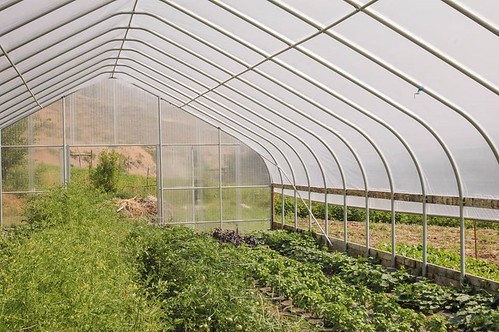
Cameron Green stands among the tomatoes in the high tunnel she operates with Eric Wittenbach.
Some people leave a legacy for their children. Cameron Green and Eric Wittenbach plan to leave theirs to Mother Nature.
A philosophy of sustainability guides them on their eight-and-a-half-acre farm in Okanogan, Washington. Green and Wittenbach both come from a background of working the land; picking fruit in commercial cherry orchards, pruning and thinning threes, and growing vegetables in the Methow Valley for a local CSA. This has given them a close connection to nature, and when they bought their land eight years ago, their intentions were to make it as sustainable as possible.
As beginning small-scale farmers, Green and Wittenbach knew they needed some help. Working with a local forestland owner led them to USDA’s Natural Resources Conservation Service (NRCS). Their first priority was to work with an NRCS conservation planner to create a strategy for growing organic crops on their land now, and return it to a native, natural system in the future.
Working with NRCS, Green and Wittenbach received Environmental Quality Incentives Program funding to install a seasonal high tunnel. They use their high tunnel to extend the growing season for small organic row crops, including garlic, onions, basil, kale, chard, tomatoes, and many others.
Seasonal high tunnels can help farmers improve plant and soil quality, reduce nutrient and pesticide use, and reduce energy use by providing consumers with a local source of fresh produce.
“As small farmers, we could’ve never afforded to get something like this. It was huge to have NRCS help us. We wouldn’t have even considered it. It’s definitely helped us a ton,” said Green.
The Methow Valley couldn’t have been a better place for Green and Wittenbach to purchase land – it’s a mecca for locally grown organic food and regenerative land practices.
Not only did Green and Wittenbach get help extending their growing season, they also learned a lot about keeping their soil healthy and functioning. In addition to row crops within their high tunnel, Green and Wittenbach also plant hearty, weather-resistant vegetables in the bare ground. During the off season though, they rely on cover crops like oats and rye to protect their soil from erosion, supply organic nutrients, and increase nitrogen levels.
“We demand a lot from the soil with vegetables and rotations, so we are trying to incorporate more things that can be in the land for longer, and also treat the perimeters to reduce weeds, and establish native plants so we have less work,” Wittenbach said.
Keeping their land as regenerative as possible is paramount to the way Green and Wittenbach manage their farm. In the future, they want to bring in more permaculture components, edible native plants that will take less care, and more perennials so they don’t have to worry about tilling the soil at all. Most of all though, they want to leave the land the way Mother Nature intended.
“If we ever decide to quit, we want to be able to turn the land back to native grasses,” said Green. “We really just want to preserve the native habitat that was already here,” she continued.
To learn more about USDA assistance for new farmers, visit www.usda.gov/newfarmers. To learn about the Environmental Quality Incentives Program and how NRCS can help you install conservation practices on your land, including information on seasonal high tunnels and conservation assistance for Organic Farmers and Ranchers, contact your local USDA service center or learn how to Get Started with NRCS online.

Diverse organic crops are growing in this high tunnel in Washington State.
No comments:
Post a Comment
Note: Only a member of this blog may post a comment.